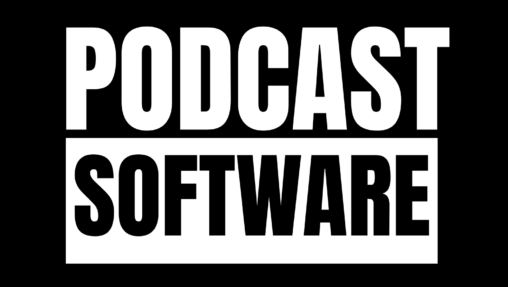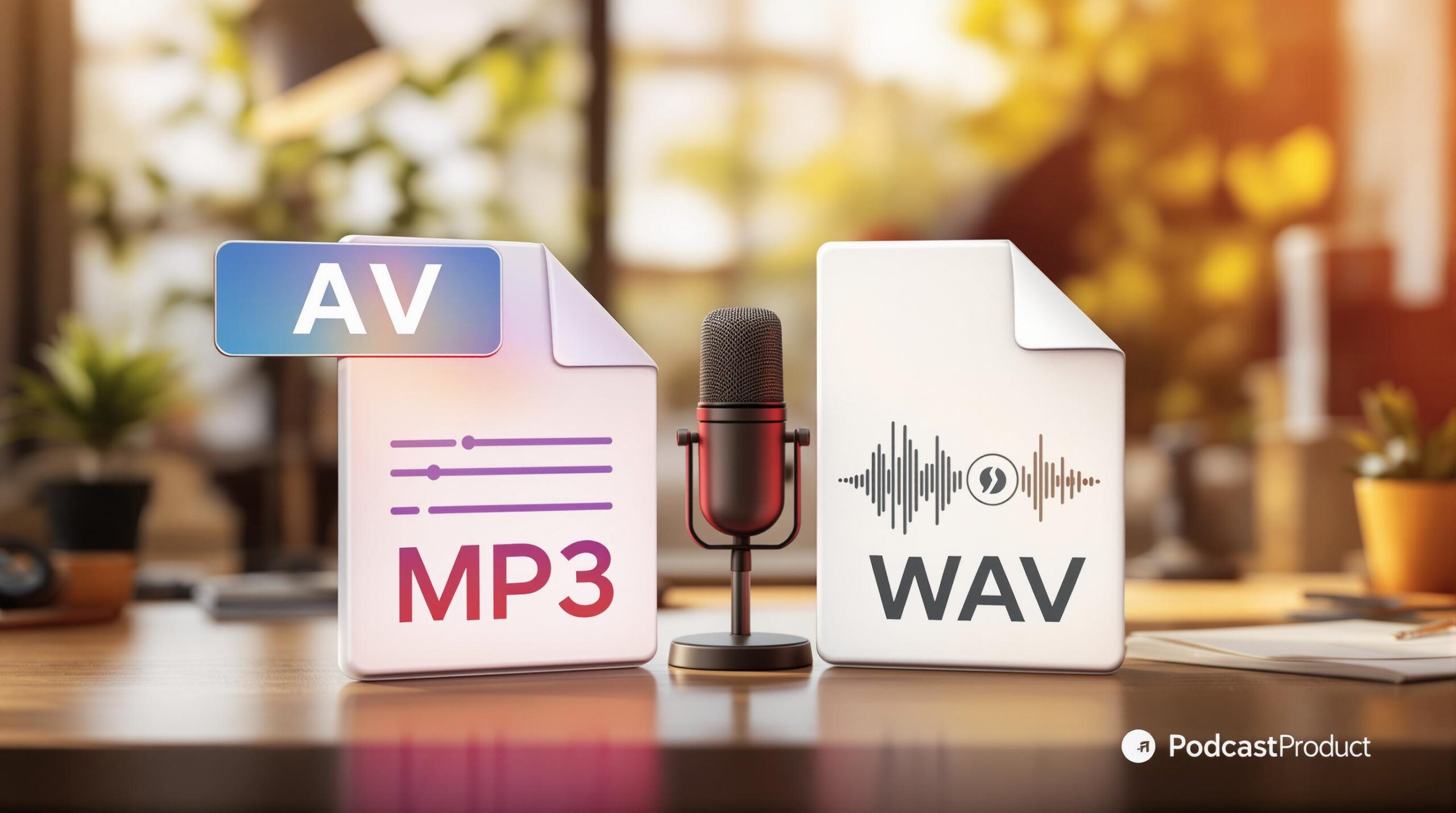MP3 is the go-to format for podcast distribution, while WAV is ideal for recording and editing. Here’s why:
- MP3: Small file size (3-5 MB for 3 minutes), universal compatibility, great for streaming and saving storage space.
- WAV: High-quality, lossless audio (30-40 MB for 3 minutes), perfect for production and detailed editing.
Quick Comparison
| Feature | MP3 | WAV |
|---|---|---|
| File Size | Small (3-5 MB) | Large (30-40 MB) |
| Compression | Lossy | Lossless |
| Audio Quality | Good to Excellent | Full Fidelity |
| Editing Flexibility | Limited | High |
| Ideal Use Case | Distribution | Recording/Editing |
Pro Tip: Record and edit in WAV for the best quality, then convert to MP3 for easy sharing and lower hosting costs.
WAV vs MP3 & Why Audio Formats Are Important
Overview of MP3 and WAV Formats
In podcasting, balancing quality with efficiency is crucial. To achieve this, it’s important to understand the differences between MP3 and WAV formats.
MP3 Explained
MP3 (MPEG Audio Layer 3) is the go-to format for podcast publishing. It compresses audio by removing some data, resulting in smaller file sizes that are ideal for distribution. For example, a 3-minute MP3 file typically uses just 3-5 MB, compared to the 30-40 MB required for a WAV file [2].
Here’s why MP3 is so popular:
- Compact and widely compatible: Its small size and universal support make MP3 perfect for online sharing and streaming [2].
- Efficient storage: MP3 files reduce audio size by about 90%, making them easy to store [2].
WAV Explained
WAV (Waveform Audio File Format) is the top choice for professional audio recording and editing. Unlike MP3, WAV files don’t lose any data during compression, preserving the original audio’s full quality. This makes them especially useful during production [2][3].
Key features of WAV files include:
- High audio accuracy: With better bit depths and sampling rates, WAV files ensure top-tier sound quality.
- No data loss: The original recording remains intact, without any degradation.
- Great for editing: WAV files are ideal for detailed post-production work.
"WAV files are preferred in applications where critical audio quality is necessary, such as music or sound production. They are also better suited for recordings with large dynamic ranges and high-frequency content." [2]
Here’s a quick comparison of the two formats:
| Feature | WAV | MP3 |
|---|---|---|
| File Size | Large (30-40 MB/3 min) | Small (3-5 MB/3 min) |
| Compression | None (Lossless) | Yes (Lossy) |
| Quality | Full fidelity | Good to excellent |
| Editing Flexibility | High | Limited |
| Storage Requirements | Substantial | Minimal |
These differences are key to understanding how MP3 and WAV formats meet varying needs for file size, quality, and compatibility.
Differences Between MP3 and WAV
File Size Comparison
One major difference between MP3 and WAV files is their size. A 3-minute WAV file typically takes up 30-40 MB, while an MP3 of the same length uses only 3-5 MB [2]. This makes MP3 a better choice for podcast hosting, where storage and bandwidth are often limited.
Compression and Quality
MP3 files use lossy compression, which reduces file size by cutting out frequencies that are less noticeable to the human ear. This can slightly reduce quality, especially at lower bitrates. On the other hand, WAV files maintain full audio fidelity, making them better suited for audio with:
- Complex musical layers
- Detailed sound effects
- Wide dynamic ranges
- High-frequency elements
Format Compatibility
MP3 files are supported by nearly all devices and platforms, making them highly accessible. WAV files, while offering better audio quality, are less compatible across devices [2][3].
Here’s a quick overview of how MP3 and WAV stack up for podcasters:
| Characteristic | MP3 | WAV |
|---|---|---|
| Ideal Use Case | Distribution and streaming | Production and editing |
| Processing Requirements | Low | High |
| Podcast Hosting Efficiency | Great | Limited |
| Post-Production Flexibility | Basic | Advanced |
| Audience Accessibility | Universal | Restricted |
| Production Stage Best For | Final distribution | Recording and editing |
sbb-itb-9f49a8d
Selecting the Best Format for Podcast Publishing
Key Considerations
When deciding between MP3 and WAV formats, think about storage space, audience preferences, and the overall listening experience. While some listeners might care deeply about top-tier audio quality, most casual listeners won’t notice minor differences. With that in mind, here’s a breakdown of when to choose MP3 or WAV.
Choosing MP3
MP3 is the standard for podcasting because of its small file size and broad compatibility. At 320 kbps, MP3 files strike a solid balance between quality and efficiency. They’re around 90% smaller than WAV files, work seamlessly across platforms, and are perfect for streaming. This makes MP3 ideal for reducing hosting costs and improving playback speed.
For example, a 30-minute podcast in MP3 format typically takes up just 30-50 MB of storage. This makes it a practical choice for hosting platforms and listeners with limited storage on their devices [2].
Choosing WAV
WAV files are a better choice for situations that demand high-quality audio, like professional production or music-heavy podcasts. With lossless compression and a much higher bitrate (around 1,411 kbps), WAV files maintain the original audio detail, which is crucial for projects requiring top-notch sound.
"WAV files are better suited for capturing a wider range of dynamic levels and high-frequency content" – Gumlet [2]
Experts recommend recording in WAV to capture the best audio quality, then exporting to MP3 for distribution [1][3]. In short, WAV shines during production, but MP3 is the preferred format for sharing your podcast with the world.
Conclusion: Making an Informed Choice
Deciding between MP3 and WAV formats comes down to your podcast’s goals. MP3 stands out for its smaller file sizes and broad compatibility, making it ideal for distribution. On the other hand, WAV delivers better audio quality, which is crucial during production. This choice affects your podcast’s accessibility, storage needs, and overall sound quality.
MP3 has become the go-to format for most podcasters because of its practicality. Many creators record in WAV to maintain quality, then convert to MP3 for easier sharing and storage efficiency [1][3].
To simplify these decisions, tools and platform recommendations from Podcastsoftware.co can help ensure smooth workflows and compatibility. The right software can make a big difference when juggling formats for production and distribution.
FAQs
What is the best audio format for podcasts?
The MP3 format with a 128 kbps bitrate is a top choice for publishing podcasts. It strikes a great balance between sound quality and file size, making it ideal for streaming and downloading spoken-word content. Major platforms like Spotify and Apple Podcasts recommend MP3 for these reasons [1][3].
Is MP3 or WAV better for podcasts?
It depends on where you are in the podcast production process. WAV files are great for recording and editing because they maintain full audio quality. On the other hand, MP3 files are perfect for distribution due to their smaller size and universal compatibility.
Most podcasters follow a mixed approach: they record and edit in WAV for the best quality, then convert to MP3 for easy sharing. This method combines professional production standards with practical distribution needs, ensuring both quality and accessibility [1][3].

